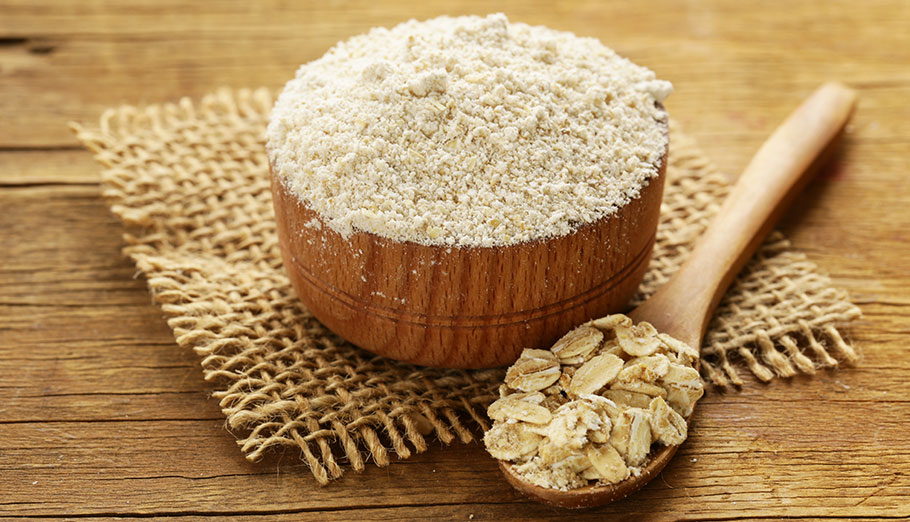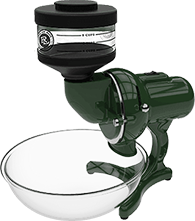Oat

Overview (Gluten Free)
As you would expect, oat flour is milled from whole oats. It is very healthy flour, high in soluble fiber (more than in any other grain), protein and healthy fats. Oat flour is used both in baking and for breading or thickening. When used for baking, it imparts a mild, nutty sweetness to your recipes.
In order to make oat flour, you need hulled oats—oats which have had the tough outer husk removed. Virtually all oats you will find in stores have been hulled and steamed (groats), rolled or steel cut.
Because oats do not have gluten, baked goods made entirely with oat flour will not rise or stick together. You have to mix it with other flours, xantham gum or some other gluten-free binder if you want to get good results. You can substitute up to 20% of the flour called for in a recipe with oat flour. You can also try blending oat flour with buckwheat or rice flour.
Although oats are gluten-free, there is the possibility of them containing trace amounts of gluten from contact with other gluten containing foods during processing—enough to cause serious problems for those with wheat allergies and celiac disease. If you need to be sure the oats you buy are gluten-free, look for oats that say “certified gluten-free” on the packaging.
Nutrition
Oats are a nutritional powerhouse, with more protein, soluble fiber and healthy fats than most whole grains. They are also very low in cholesterol and sodium.
Note: Weight of a cup (or partial cup) of flour varies depending upon whether it is lightly sprinkled into a measuring cup or compacted. Most recipe measurements are based on sifted flour as a way to arrive at more uniform measurement.
Gluten Content & Allergen Information
Oats are gluten-free and flour milled from them is generally a fine alternative for anyone with gluten intolerance or Celiac disease. However, one must be cautious to only buy “Certified gluten-free” oats.
Additionally, it should be noted there are people who have a sensitivity to avenin, a glutinous protein in oats which is similar to the gluten in wheat and other grains. There are also some individuals with celiac disease who experience bad reactions to oats even when they are certified gluten-free.
Nutrition Facts
| Serving Size | 1 Cup |
| Calories | 607 |
| Total Fat 11g | 14% |
| Cholesterol 0mg | 0% |
| Sodium 3mg | 1% |
| Carbohydrates 89g | 30% |
| Dietary Fiber 31g | 104% |
| Total Sugars 3g |
| Protein 20g |
| Vitamin D 0mcg | 0% |
| Calcium 47mg | 4% |
| Iron 6mg | 34% |
| Potassium 0mg | 0% |
* The % Daily Value (DV) tells you how much a nutrient in a serving of food contributes to a daily diet. 2,000 calories a day is used for general nutrition advice.
Diet Compatibility
Paleo Diet
The Paleo Diet seeks to emulate the hunter-gatherer diet of our stone-age ancestors. The emphasis is on wild plants and meats similar to what ancient man would have consumed. As such, dairy products, refined sugar and processed oils are off limits. While many Paleo Diet followers also avoid grains, there is ample archaeological evidence to show that grains were part of Paleolithic era man’s diet.
Compatibility with Oat Flour:
Not Compatible

Mediterranean Diet
This diet seeks to emulate the diets of those living along the Mediterranean coast, with an emphasis on fresh fruits and vegetables, seafood/fish at least twice a week, limited servings of poultry, and only occasional sweets and red meat.
Compatibility with Oat Flour:
Compatible

Gluten-Free Diet
As the name suggests, the gluten-free diet eliminates all foods with gluten. Although most of those on a gluten-free diet are on it out of necessity—either due to severe wheat allergies or Celiac disease—many have embraced a gluten-free diet as being healthier.
Compatibility with Oat Flour:
Compatible (with Caution)

Macrobiotic Diet
Although there are many versions of macrobiotic diets, the common thread is that they emphasize natural, whole foods, grown locally and organically. Whole grains, vegetables, legumes, fruits, seeds and nuts, and occasional seafood are all integral to the diet. Red meats, dairy, poultry, eggs and processed foods are off the menu.
Compatibility with Oat Flour:
Compatible in small amounts

Acid Alkaline Diet
This diet aims to restore the slightly alkaline state of the body, which is believed to be ideal. By focusing on a diet high in vegetables, fruits, sprouted grains, lentils, almonds and soy products, the goal is to have a balance of 80% alkalizing foods and 20% acid forming foods.
Compatibility with Oat Flour:
Compatible – Oat Flour is considered to be of neutral acidity

Low-Carb Diet
As the name suggests, this diet focuses on reducing carbohydrates in the diet to lose weight. The theory is that by staying away from high-carb foods like pasta and bread and eating low carb, high fiber vegetables and fruits instead, your body will go into ketosis and you will lose weight. This diet is sometimes referred to as a ketogenic diet.
Compatibility with Oat Flour:
Compatible but unlikely to be of much relevance to this diet

Atkins Diet
The Atkins Diet is a historically popular low carb diet, instructing dieters not to worry about their calories but to monitor and minimize their intake of sugar and carbohydrates. According to Dr. Atkins, depriving the body of its primary energy sources causes the body to burn fat.
Compatibility with Oat Flour:
Compatible

“We love the mill! We use it every day for things from bread, to pastry and it is phenomenal. The biggest selling point for me was the fineness since that would mean we can really do some great pastry with it in addition to bread. It definitely has been great!"
BEN FROM NORTH CAROLINA

